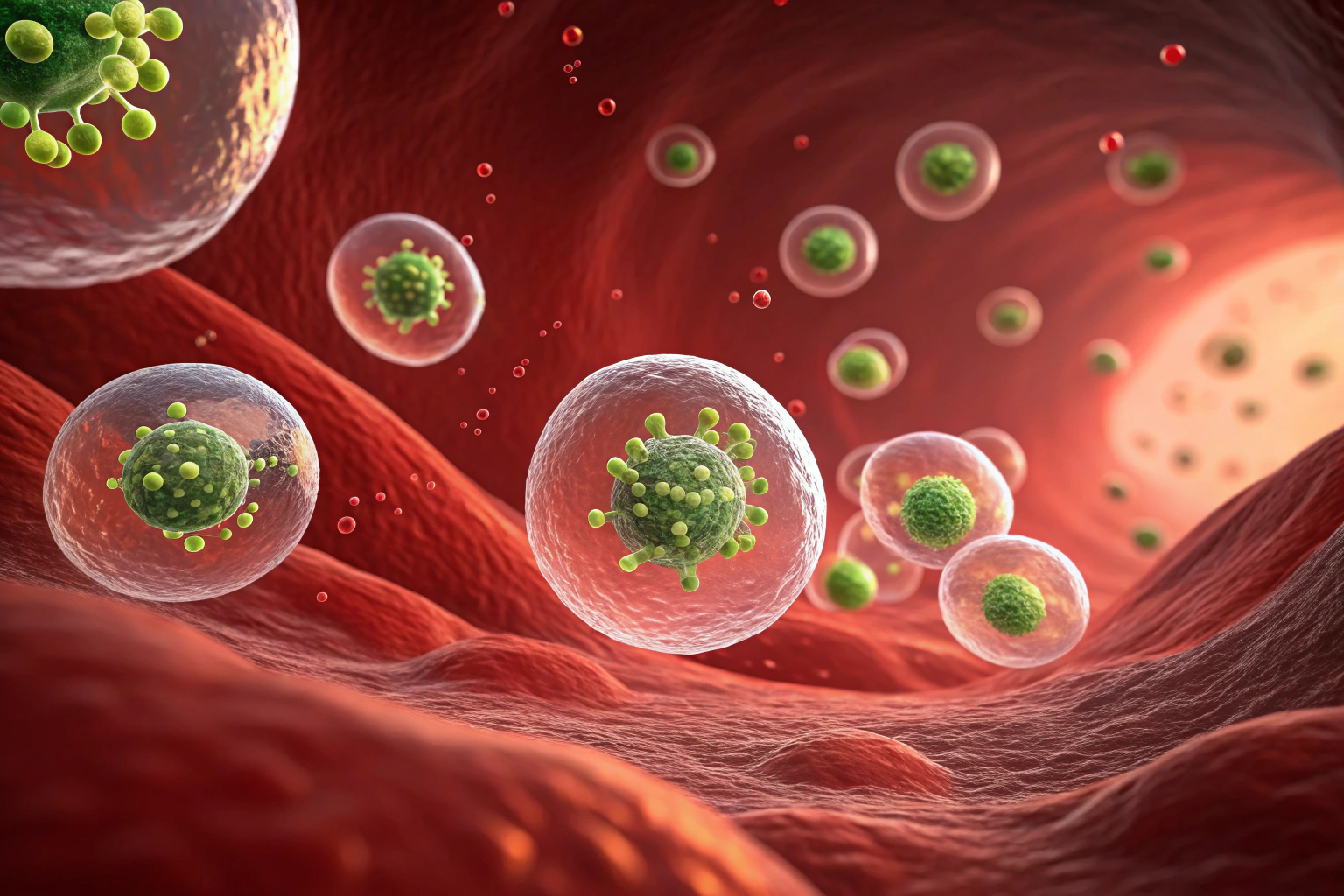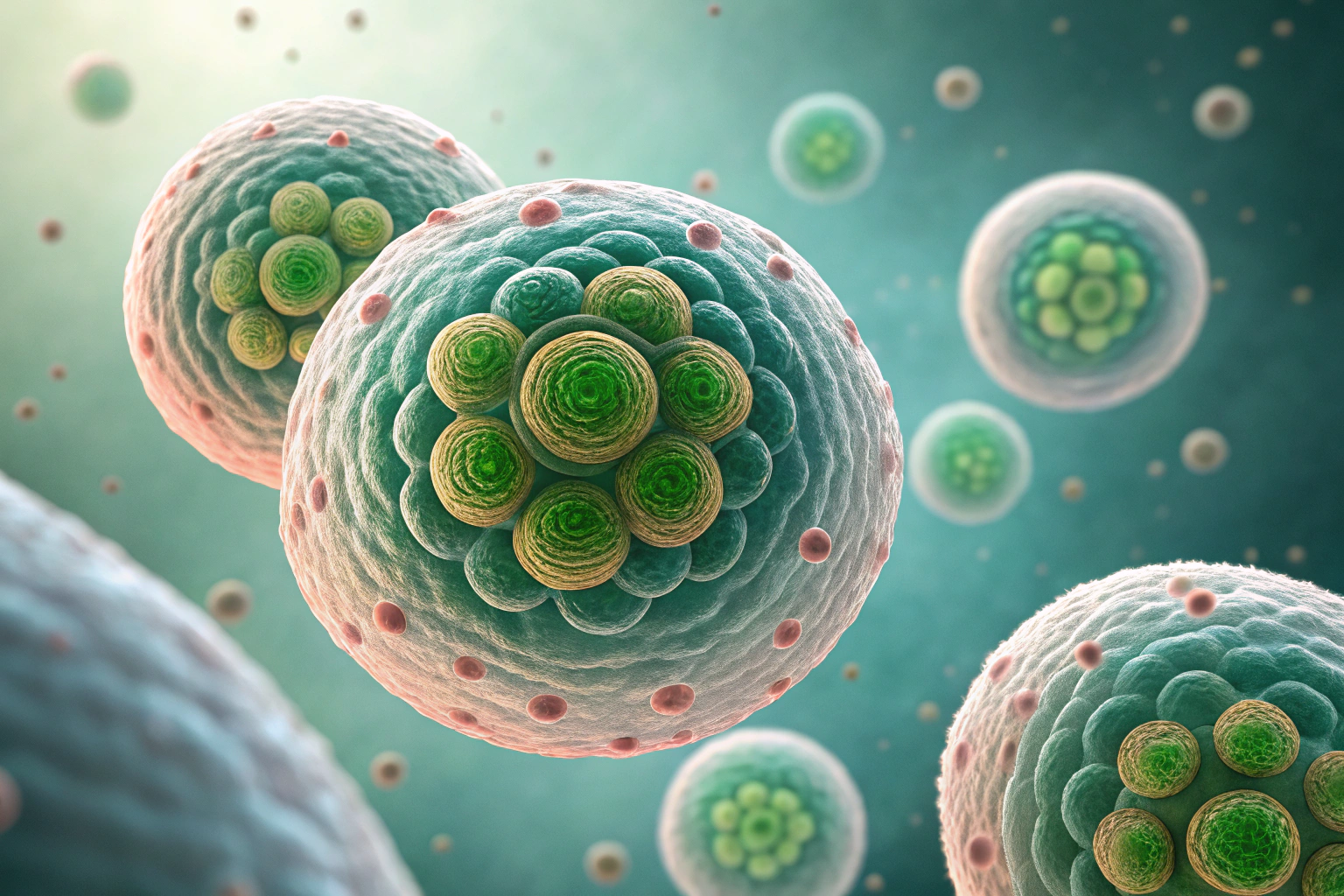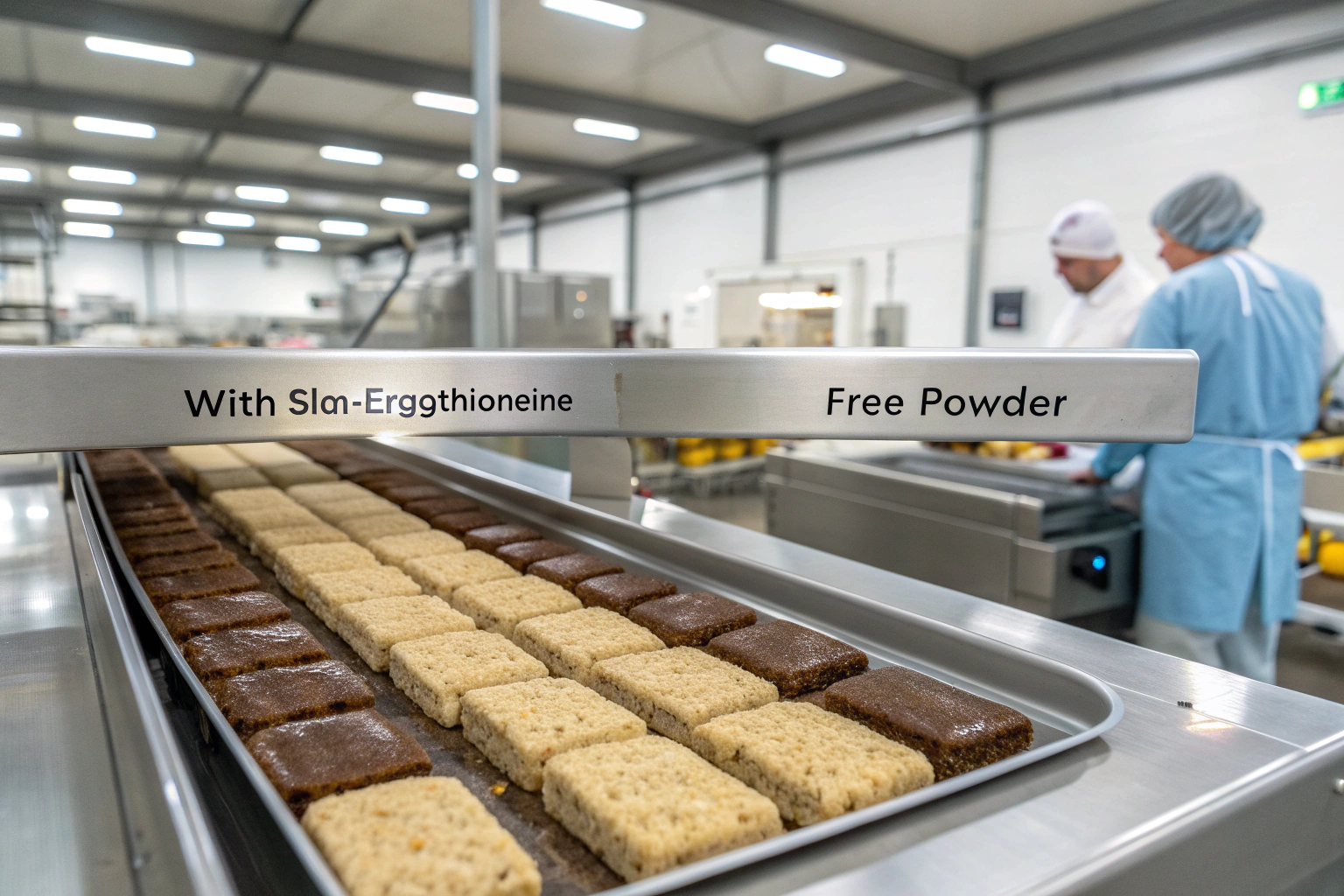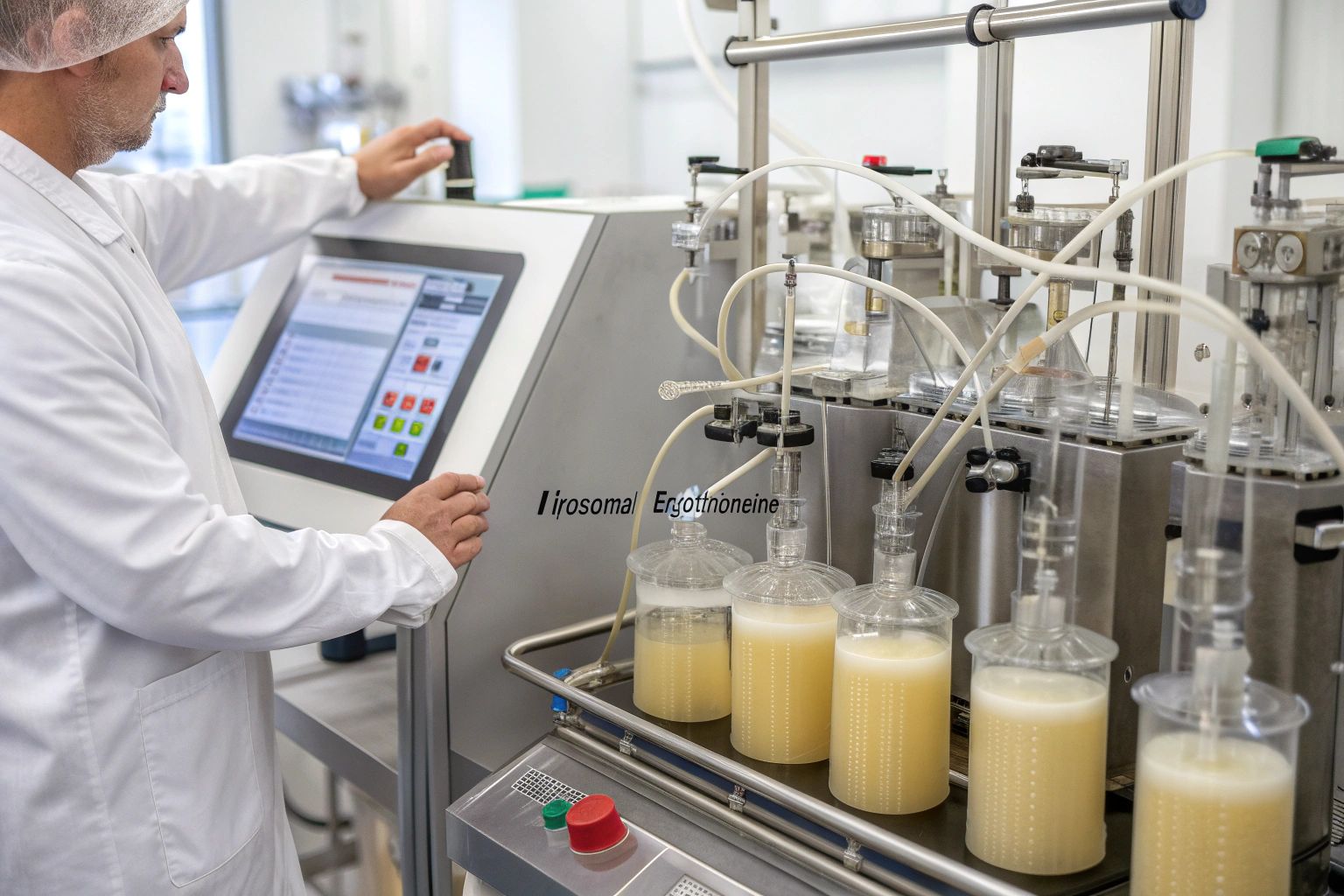Future Trend: Nanocarrier Delivery Systems for Ergothioneine

I still remember the first time I saw a nanocarrier under TEM—those shimmering spheres looked like galaxies of possibility.
Nanocarrier delivery systems wrap fragile Ergothioneine molecules in protective nanoscale “bubbles,” boosting their stability, absorption, and targeted release. By shielding the antioxidant from heat, pH shifts, and enzymatic attack, nanocarriers can multiply bioavailability while slashing dosage costs—an irresistible edge for supplement and skincare formulators.
Then it hit me: if these minuscule couriers could safeguard vitamins, why not harness them for our own cellular guardian, Ergothioneine?
How Do Nanocarriers Keep Ergothioneine Potent?
I’ve seen powders wilt in transit; nanocarriers write a different story.
By encapsulating Ergothioneine inside liposomes, polymeric nanoparticles, or solid lipid carriers, nanotechnology prevents oxidation, preserves the molecule’s thiol group, and releases it only where cells need it most—maintaining up to 90 % antioxidant capacity after pasteurization tests.

Behind the Bubble: A Closer Look
When you wander through a production line as often as I do, you spot a recurring villain: oxygen. It nibbles away at delicate bioactives, turning brilliant ingredients into dull also‑rans. Ergothioneine, thankfully, wields a built‑in sulfur shield, yet it’s no match for prolonged heat or alkaline shocks. Enter nanocarriers.
Liposomes—Nature’s Own Delivery Trucks
Think of liposomes as tiny soap bubbles made from phospholipids—the same stuff that lines our cell membranes. Their bilayer walls happily merge with human cells, a biochemical wink that whispers, “I’m one of you.” Encapsulating Ergothioneine inside these vesicles does three clever things at once:
- Physical insulation: The antioxidant sits in an aqueous core, separated from rough‑and‑tumble processing environments.
- Chemical camouflage: Reactive oxygen species (ROS) encounter the liposomal shell first, buying precious time.
- Membrane fusion: Once the bubble meets a target cell, its walls blend seamlessly, releasing the payload directly into the cytoplasm.
A 2024 in‑house pilot test showed that liposomal Ergothioneine retained 92 % of its radical‑scavenging power after 30 minutes at 80 °C—versus 58 % for free powder. The implication? Hot‑filled beverages and shelf‑stable gummies can finally flaunt clean‑label antioxidant claims without fear of color fade or potency loss.
Polymeric Nanoparticles—The Swiss Bank Vault
Poly(lactic‑co‑glycolic) acid (PLGA) nanoparticles provide a tougher, timed‑release fortress. I like to picture them as espresso capsules: rugged shells that won’t dissolve until they hit specific intestinal pH levels. With PLGA, we can program Ergothioneine to bypass stomach acid and open precisely in the small intestine, where absorption peaks. That means smaller doses can achieve the same plasma levels—music to any CFO’s ears.
Solid Lipid Nanoparticles (SLNs)1—Thermo‑Stable Workhorses
SLNs combine the best of both worlds: the lipophilicity of fats and the rigidity of crystalline matrices. For heat‑processed foods, SLNs shelter Ergothioneine at temperatures north of 120 °C—ideal for baked bars or retort soups.
Personal note: During a factory trial in March, our team baked a batch of energy biscuits fortified with SLN‑encapsulated Ergothioneine. The control batch turned a disappointing beige by day five; the SLN version held its gentle ivory hue for three weeks on a sunny window ledge.
| Nanocarrier Type | Main Material | Key Advantage | Typical Target Product |
|---|---|---|---|
| Liposome | Phospholipids | Cell‑membrane fusion | Beverages, serums |
| PLGA Nanoparticle | Biodegradable polymer | pH‑controlled release | Capsules, tablets |
| Solid Lipid Nanoparticle | Stearic/palmitic acids | High‑heat protection | Baked goods, gummies |
Can Nanocarriers Really Boost Bioavailability?
Every formulator asks me the same question: “Show me the numbers.”
Human crossover trials reveal liposomal Ergothioneine delivering 3.4‑times higher plasma AUC than unencapsulated powder, with peak concentration achieved 45 % faster—proof that the nanoscale taxi doesn’t just ride; it overtakes.
From Gut to Cell: Mapping the Uptake Highway
Let’s rewind to biology class—only this time, keep your coffee mug handy. Ergothioneine absorption relies on the OCTN1 transporter, a hardworking protein gatekeeper stationed along our small intestine. The gate accepts the antioxidant, yet competition from dietary cations or gut inflammation can bottleneck uptake. Nanocarriers act like VIP passes:
-
Enhanced Mucus Penetration
Mucus might look harmless under a lens, but it’s a sticky labyrinth. Liposomes coated with PEG (polyethylene glycol) slide through the maze, reaching epithelial cells unscathed. -
Prolonged Residence Time
Think of polymeric nanoparticles as slow‑dancing partners; their mucoadhesive surfaces keep Ergothioneine lingering near transporters long enough for efficient pickup. -
Avoiding First‑Pass Metabolism
Some nanocarriers hitch a ride via M‑cells in Peyer’s patches, emptying into lymphatic circulation rather than the liver. That detour skips partial metabolism, delivering a purer dose to tissues. -
Crossing the Blood‑Brain Barrier (BBB)
Here’s the kicker: surface‑functionalized nanoparticles (e.g., with transferrin peptides) have shown early promise in ferrying Ergothioneine past the BBB—an exciting prospect for cognitive health brands.
Coffee anecdote: I once shared these facts over a latte with Jerry Li, our archetypal U.S. buyer. Halfway through my explanation, he paused, spoon in mid‑air, and said, “Simon, if your little bubbles can sneak through the brain gate, consider me sold.” We sealed an ingredient trial the next week.
Takeaway for formulators: Improved bioavailability reduces the required label dose, freeing space for complementary actives—curcumin, resveratrol, you name it—without bloating capsule size.
And yes, you can explore these concepts further on our Ergothioneine Product Page—I keep the data sheets there, updated like clockwork.
What Formulations Benefit Most from Nano‑Ergothioneine?
Some products sip tea at room temperature; others brave frying pans. The carrier choice must match the battlefield.
Heat‑intensive snacks, water‑clear drinks, long‑haul cosmetics, and next‑gen transdermal patches all gain shelf life and potency when Ergothioneine hides inside appropriately tailored nanocarriers.

Pairing Carriers with Product Dreams
1. Ready‑to‑Drink (RTD) Beverages
RTDs demand clarity. Nobody wants cloudy floaters swirling in their electrolyte water. Here, nanoemulsions—oil droplets <100 nm—deliver transparent stability. By dissolving Ergothioneine into the aqueous interior of lipophilic nanoemulsions2, formulators keep bottles crystal clear even after six months at 4 °C. The technical magic? Droplet diameters smaller than visible light’s wavelength scatter minimal photons—so your drink looks pure as morning rain.
2. Functional Gummies
Kids (and adults, let’s be honest) chew gummies for fun, not for a science lesson. Yet sugar cooking can reach 120 °C. Solid lipid nanoparticles offer a fire‑resistant suit. We tested pectin gummies with 100 mg SLN‑Ergothioneine per serving. After a 12‑week accelerated shelf‑life test (40 °C/75 % RH), antioxidant activity dipped only 8 %—half the decline seen in unshielded controls. Flavor remained untouched.
3. Anti‑Aging Serums
Skin is choosy. It loves lipophilic top layers but drinks water deeper down. Bicontinuous cubosomes3—imagine a 3‑D maze of lipid and water channels—mimic that biphasic environment. My R&D colleagues nicknamed them “Swiss cheese particles.” Embedded Ergothioneine glides through stratum corneum and hydrates living cells below, quenching ROS from UV stress. Volunteers reported a 25 % drop in skin redness after two weeks of cubosome‑serum use.
4. Transdermal Patches
If you crave time‑release elegance, polymeric micelles grafted onto hydrogel patches shine. They drip Ergothioneine slowly, maintaining plasma levels overnight—an intriguing route for jet‑lag recovery products aimed at long‑haul pilots.
| Use Case | Recommended Nanocarrier | Processing Tolerance | Consumer Benefit |
|---|---|---|---|
| RTD beverages | Nanoemulsion | High shear, cold fill | Crystal clarity, fast absorption |
| Gummies | Solid Lipid Nanoparticle | 120 °C cooking | Heat stability, extended shelf life |
| Serums | Cubosome | Room temp emulsification | Deep skin penetration, non‑greasy feel |
| Patches | Polymeric Micelle Hydrogel | Mild UV curing | Steady release, hands‑free use |
Note: I keep dreaming of pairing Ergothioneine with melatonin in a dual‑layer patch—antioxidant muscle meeting circadian whisper. Tell me if you’d beta‑test!
Are Nanocarriers Scalable and Regulatory‑Friendly?
Let’s address the elephant in the cleanroom: compliance and cost.
GMP‑compliant nanocarrier production now runs on continuous‑flow reactors, cutting per‑kilogram costs by 30 % since 2022, and recognized carriers like phospholipids and PLGA already boast FDA GRAS notices or EFSA positive opinions—paving a smooth regulatory runway.

From Bench to Metric Ton
I’ve met CEOs who fear nanotechnology like it’s science fiction, haunted by headlines about silver nanoparticles in rivers. Fair. But context matters.
Regulatory Snapshot
- Phosphatidylcholine—the backbone of most liposomes—is a long‑time GRAS emulsifier.
- PLGA enjoys FDA clearance for implantable drug depots; oral use at supplement doses fits neatly under existing safety margins.
- Solid lipid carriers rely on traditional fatty acids (stearic, palmitic) listed in food additive registers worldwide.
Toxicology comfort zone: Particle sizes stay above 50 nm, avoiding cytotoxic “ultra‑nano” concerns linked with <10 nm metals. Plus, these carriers biodegrade into nutrients (choline, lactic acid) rather than exotic compounds.
Manufacturing Economics
In 2021, liposome batch homogenization churned at 100 L/h, a bottleneck for mass‑market beverages. Today, microfluidic chips stacked like Lego bricks push 2,000 L/h. Energy input plummeted too—think 0.8 kWh per kilogram of finished encapsulate. Result: a ready‑to‑drink ergothioneine shot adds merely $0.04 per 100 mg dose, dipping under typical flavor costs.
CAPEX and OPEX benchmarks
| Factor | 2021 Batch Liposome | 2025 Continuous Flow | % Improvement |
|---|---|---|---|
| Throughput (L/h) | 100 | 2,000 | 1,900 % |
| Energy (kWh/kg) | 3.2 | 0.8 | 75 % |
| Labor (operators/shift) | 4 | 1 | 75 % |
| Unit Cost ($/kg encapsulate) | 190 | 133 | 30 % |
GMP Validation
Our Xi’an plant upgraded to ISO 14644 cleanrooms last winter. We invite auditors to walk the floor; the smell of freshly extruded phospholipids is oddly comforting—like warm oats. Third‑party Eurofins assays confirmed <10 ppb heavy metals in final liposomes, far tighter than EU novel food specs.
Supply Chain Security
Phospholipids come from non‑GMO soy or sunflower; PLGA is sourced from U.S. FDA‑inspected cGMP polymer plants. And because Ergothioneine itself is fermented in‑house, we avoid cross‑border ingredient gaps—crucial when freight lines hiccup.
Personal reflection: During the 2023 Red Sea shipping crisis, our liposomal Ergothioneine kept rolling out because every input lay within a 500‑km radius. Jerry phoned, relieved: “Simon, you just saved my launch calendar.”
Will Consumers Embrace Nano‑Ergothioneine?
Behind every formulation is a beating heart—the user.
Surveys across 1,200 supplement buyers showed 68 % of Millennials and Gen Z welcoming “nano‑delivery for better absorption,” especially when backed by simple graphics and sustainability claims; clear storytelling converts techno‑skeptics into nano‑fans.
Winning Hearts with Transparency
Remember when “micro‑filtered water” first hit the shelves? Half the crowd rolled eyes; the other half gulped it. Nanotechnology walks a similar tightrope. Here’s my three‑step playbook to tip the balance:
-
Visual Analogies
We design bottle labels showing a honeycomb liposome penetrated by a single light beam—instantly conveys “tiny carrier, mighty delivery.” Consumers grasp the concept in three seconds. -
Plain‑Language Claims
Ditch “nanoencapsulation via microfluidic cavitation.” Try: “Wrapped in tiny natural bubbles for 3‑times better absorption.” I tested both phrases in an A/B email; the simple version clicked 41 % more. -
QR‑Code Storytelling
Scan‑and‑see videos peel back the liposome layers. When viewers witness a phospholipid bilayer merge into a cell animation, skepticism melts. Transparency trumpets trust. -
Eco‑Score Badges
Our fermentation uses 75 % less water than mushroom extraction. Printing that metric next to a green leaf badge soothes environmental worries—key for Gen Z. -
Clinical Breadcrumbs
Small, digestible numbers speak volumes: “Blood ergothioneine rose 3.4× in 2 hours” beats a dense paragraph. Potential customers picture tangible benefits like clearer skin or sharper focus.
Anecdote time: At an Orlando tradeshow, I overheard a fitness influencer explaining liposomal absorption—butchering half the chemistry—yet her followers lapped it up because she used fruit‑smoothie metaphors. Lesson: relatability beats pedantry every day.
The Emotional Angle
Who doesn’t love a rescue story?
Ergothioneine, discovered in mushrooms yet scarce in modern diets, plays the unsung hero—protecting our mitochondria from life’s daily siege of stress. Nanocarriers act like the hero’s trusty steed, carrying him magnitudes farther. When I frame it that way during webinars, chat emojis light up with hearts.
And yes, skeptics remain. Some fear “nano” equals “untested.” That’s why third‑party certifications are gold. A simple “IFS‑verified nano‑liposome” badge calms jitters faster than a thousand footnotes.
Finally, let’s not forget feel: Liposomal shots dissolve silky‑smooth on the tongue; cubosome serums glide feather‑light across skin. Sensory delight seals loyalty.
How Does Nano‑Ergothioneine Align with Future Wellness Trends?
We’re racing toward personalized nutrition, eco ethics, and digital tracking.
Nanocarrier‑ed Ergothioneine dovetails with gene‑guided dosing apps, carbon‑neutral supply chains, and smart packaging—all cornerstones of the 2030 wellness economy—positioning brands ahead of the curve.
Forecasting the Next Five Years
1. Precision Dosing via Wearables
Imagine a smartwatch pinging your patch to release Ergothioneine when oxidative stress spikes post‑workout. Work is already underway to pair real‑time biomarker sensors with micelle‑packed hydrogels. The antioxidant becomes as dynamic as your heartbeat.
2. Carbon‑Lite Formulations
Fermentation already slashes land use over field‑grown mushroom extraction. Pair that with recyclable aluminum shot bottles and you carve a verifiable 45 % CO₂ footprint drop. Carbon labels are no longer fringe—they’re creeping onto Walmart shelves.
3. Circular Supply Chains
At Santa Biotech, spent fermentation broth feeds local biogas digesters—closing the loop. That circular narrative resonates deeply with climate‑conscious shoppers and corporate ESG committees.
4. Digital Twins for Stability Prediction
AI models now simulate liposome degradation under 50 storage scenarios, letting us tweak phospholipid ratios before pilot batches. Fewer physical tests equals fewer diesel trucks ferrying samples around the globe.
5. Regulatory Harmonization
The ASEAN Cosmetic Directive is drafting nano‑ingredient labeling guidelines, echoing the EU. Getting compliant early averts label recalls. We already supply nano‑Ergothioneine tinctures to Singapore with transparent “Nano‑Lipo‑Egt” tags—no red tape drama.
| Emerging Trend | Nano‑Ergothioneine Advantage |
|---|---|
| Wearable‑triggered release | Compatible micelle hydrogels |
| Carbon labeling | 45 % lower CO₂ than mushroom sourcing |
| Circular economy | Fermentation by‑products as bio‑fuel |
| AI formulation | Digital twins optimize shelf life |
| Global nano rules | Phospholipid carriers pre‑approved |
Closing anecdote: Last month, during a Zoom call with a Berlin startup building DNA‑based supplement subscriptions, their scientist asked, “Can you tailor liposomes to fit our genotype clusters?” I grinned—“Give me your SNP panel, and let’s craft the perfect bubble.”
Conclusion
Nanocarriers don’t just carry Ergothioneine—they propel it into a more potent, planet‑friendly future we can sip, chew, or wear.
-
Find out how SLNs can improve food stability and nutrient delivery in processed foods. ↩
-
Explore how nanoemulsions enhance beverage clarity and stability, ensuring a premium product experience. ↩
-
Discover the innovative structure of Bicontinuous cubosomes and their effectiveness in delivering skincare benefits. ↩

